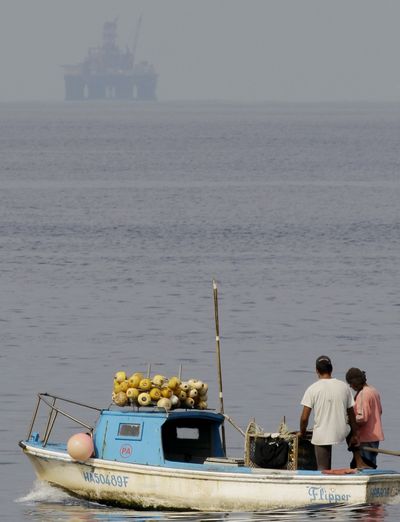Cuba joins search for offshore oil
Drilling to begin despite U.S. trade embargo hurdles

HAVANA – A huge drilling rig arrived Thursday in the warm Gulf waters north of Havana, where it will sink an exploratory well deep into the seabed, launching Cuba’s dreams of striking it rich with offshore oil.
The Scarabeo-9 platform was visible from Havana’s sea wall far off on the hazy horizon as it chugged westward toward its final drill site about 30 miles from the capital, and 60 miles south of Key West.
Spanish oil company Repsol RPF, which is leasing the rig for about $500,000 a day, said it expects to begin drilling within days to find out whether the reserves are as rich as predicted.
“The geologists have done their work. If they’ve done it well, then we’ll have a good chance of success,” Repsol spokesman Kristian Rix said by phone from Madrid.
It’s been a long, strange journey for the Scarabeo-9, Repsol and Cuba, a process shadowed at every step by warnings of a possible environmental debacle and decades of bad blood between Cuba and the United States.
The U.S. trade embargo essentially bars U.S. companies from doing oil business with Cuba and threatens sanctions against foreign companies if they don’t follow its restrictions, making it far more complicated to line up equipment and resources for the project.
To avoid sanctions, Repsol chose the Scarabeo-9, a 380-foot-long, self-propelled, semisubmersible behemoth capable of housing 200 workers. The rig qualifies for the Cuba project because it was built with less than 10 percent U.S.-made parts, no small feat considering America’s dominance in the industry.
While comparable platforms sat idle in the Gulf of Mexico, the Scarabeo-9 spent months navigating through three oceans and around the Cape of Good Hope to arrive in the Caribbean at tremendous expense.
Even after the rig is in place, the embargo continues to affect just about every aspect.
The Scarabeo-9’s blowout preventer, a key piece of machinery that failed in the 2010 Macondo-Deepwater Horizon disaster, is state of the art. But its U.S. manufacturer is not licensed to work with Cuba so replacement parts must come through secondary sources.
It’s also more complicated to do things like the maintenance necessary to keep things running smoothly and decrease the chances of something going wrong.
If it does, Cuba would be hard-pressed to respond to a major spill on its own, and getting help isn’t as simple as making a phone call to Washington. The embargo would require licenses to be issued for all manner of equipment and services for an emergency response.
Few U.S. companies so far have gotten permission to work with the Cubans in the event of a spill – representing just 5 percent of all the resources thrown at the Macondo blowout, according to an estimate by Lee Hunt, president of the International Association of Drilling Contractors.
Meanwhile cooperation between the two governments, which often struggle to see eye-to-eye on things as basic as delivering each other’s mail, has been only bare-bones.
“With any other country – Mexico, Canada or Russia – we would already have in place agreements between the coast guards of the two countries,” said Dan Whittle, Cuba program director for the Environmental Defense Fund. “There would be contingency plans written and publicly available. There already would have been drills, a comprehensive action plan for responding to a spill.”
“We don’t have that yet.”
There has been some movement.
U.S. inspectors examined the rig last week in Trinidad and gave it a clean bill of health, though notably said that did not constitute any certification. And American representatives at a regional oil meeting last month in the Bahamas were left impressed by their Cuban counterparts’ openness and willingness to share information.
But the countries’ proximity has increased fears of a disastrous spill with the potential to foul not only Cuba’s reefs and gleaming, white-sand beaches, but also, swept up by the Gulf Stream, the coast of Florida and the Atlantic Seaboard up to North Carolina.